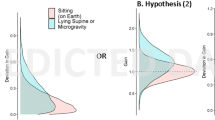Abstract.
During the 1998 Neurolab mission (STS-90), four astronauts were exposed to interaural and head vertical (dorsoventral) linear accelerations of 0.5 g and 1 g during constant velocity rotation on a centrifuge, both on Earth and during orbital space flight. Subjects were oriented either left-ear-out or right-ear-out (Gy centrifugation), or lay supine along the centrifuge arm with their head off-axis (Gz centrifugation). Pre-flight centrifugation, producing linear accelerations of 0.5 g and 1 g along the Gy (interaural) axis, induced illusions of roll-tilt of 20° and 34° for gravito-inertial acceleration (GIA) vector tilts of 27° and 45°, respectively. Pre-flight 0.5 g and 1 g Gz (head dorsoventral) centrifugation generated perceptions of backward pitch of 5° and 15°, respectively. In the absence of gravity during space flight, the same centrifugation generated a GIA that was equivalent to the centripetal acceleration and aligned with the Gy or Gz axes. Perception of tilt was underestimated relative to this new GIA orientation during early in-flight Gy centrifugation, but was close to the GIA after 16 days in orbit, when subjects reported that they felt as if they were 'lying on side'. During the course of the mission, in-flight roll-tilt perception during Gy centrifugation increased from 45° to 83° at 1 g and from 42° to 48° at 0.5 g. Subjects felt 'upside-down' during in-flight Gz centrifugation from the first in-flight test session, which reflected the new GIA orientation along the head dorsoventral axis. The different levels of in-flight tilt perception during 0.5 g and 1 g Gy centrifugation suggests that other non-vestibular inputs, including an internal estimate of the body vertical and somatic sensation, were utilized in generating tilt perception. Interpretation of data by a weighted sum of body vertical and somatic vectors, with an estimate of the GIA from the otoliths, suggests that perception weights the sense of the body vertical more heavily early in-flight, that this weighting falls during adaptation to microgravity, and that the decreased reliance on the body vertical persists early post-flight, generating an exaggerated sense of tilt. Since graviceptors respond to linear acceleration and not to head tilt in orbit, it has been proposed that adaptation to weightlessness entails reinterpretation of otolith activity, causing tilt to be perceived as translation. Since linear acceleration during in-flight centrifugation was always perceived as tilt, not translation, the findings do not support this hypothesis.
Similar content being viewed by others
Author information
Authors and Affiliations
Additional information
Electronic Publication
Rights and permissions
About this article
Cite this article
Clément, G., Moore, S.T., Raphan, T. et al. Perception of tilt (somatogravic illusion) in response to sustained linear acceleration during space flight. Exp Brain Res 138, 410–418 (2001). https://doi.org/10.1007/s002210100706
Received:
Accepted:
Issue Date:
DOI: https://doi.org/10.1007/s002210100706




